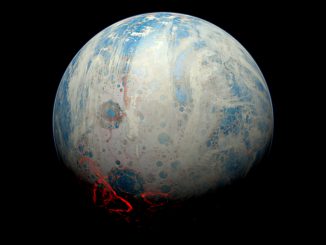
Earth






Did early Earth spin on its side?
New theoretical modelling of the ancient history of the Earth and the Moon suggests that the giant collision that spawned our natural satellite may have left Earth spinning very fast, and with its spin axis highly tilted. The simulations give new insight into the question of whether planets with big moons are more likely to have moderate climates and life.

NOAA satellite shows Moon crossing face of Earth for second time in a year
On 5 July 2016, the Moon passed between the National Oceanic and Atmospheric Administration’s DSCOVR satellite and Earth. NASA’s EPIC camera aboard DSCOVR snapped these images over a period of about four hours. In this set, the far side of the Moon, which is never seen from Earth, passes by. The last time EPIC captured this event was 16-17 July 2015.

Habitable planets may lie outside the “Goldilocks zone” in extra-solar systems
If conditions had been just a little different an eon ago, there might be plentiful life on Venus and none on Earth, according to a new hypothesis. Minor evolutionary changes could have altered the fates of both Earth and Venus in ways that scientists may soon be able to model through observation of other solar systems, particularly ones in the process of forming.

Primordial asteroid impacts a possible solution to “faint young Sun paradox”
In the first billion years of Earth’s history, the planet was bombarded by primordial asteroids, while a faint Sun provided much less heat. A Southwest Research Institute-led team posits that this tumultuous beginning may have ultimately fostered life on Earth, particularly in terms of sustaining liquid water.

Climate change creates wobbles in Earth’s spin axis
Earth does not always spin on an axis running through its poles. Instead, it wobbles irregularly over time, currently drifting toward the British Isles at 17cm per year. These wobbles don’t affect our daily life, but they must be taken into account to get accurate results from GPS, satellites and observatories on the ground.
